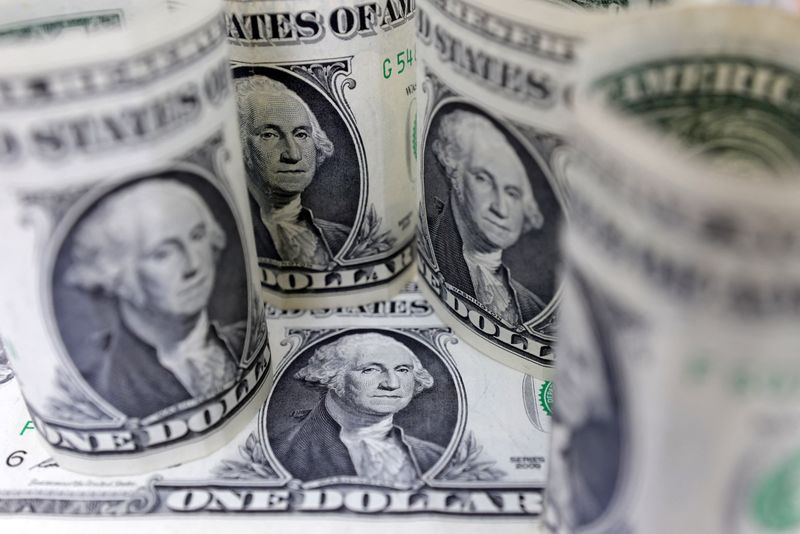Forex
Dollar slips against yen after data shows labor market weakness, rising inflation

By Chibuike Oguh
NEW YORK (Reuters) -The U.S. dollar slipped against the yen on Thursday as investors weighed data showing labor market weakness as well as a slight uptick in consumer prices, suggesting that the Federal Reserve will likely continue cutting interest rates.
Labor Department data on Thursday showed that the consumer price index increased 0.2% in September. However, in the 12 months through September the CPI climbed 2.4%, which was the smallest year-on-year rise since February 2021.
Economists polled by Reuters had forecast the CPI edging up 0.1% and rising 2.3% year-on-year.
Other data from the Labor Department also showed that the number of Americans seeking unemployment benefits surged last week, driven partly by Hurricane Helene and furloughs at Boeing (NYSE:).
“The market’s been in a bit of a tug of war between caring more about inflation versus caring more about employment,” said Brad Bechtel, global head of FX at Jefferies in New York. “Clearly, the Fed has shifted its view recently when it decided to focus more on the employment side of the equation, and then cut 50 basis points a few weeks ago and they also quickly turned around and said they may not cut 50 basis points again.”
The greenback was down 0.38% at 148.66 yen after rising to as high as 149.58 yen for the first time since Aug. 2. Bank of Japan Deputy Governor Ryozo Himino’s latest comments on Thursday supporting more rate hikes if the economy moves in line with bank projections, had helped to keep the dollar slightly weaker against the yen.
The euro dropped to its lowest since Aug. 8 against the dollar and was down 0.14% on the day at $1.0925. Against the Swiss franc , the dollar weakened 0.45% to 0.856.
The , which measures the currency against six key rivals including the yen, the pound sterling and euro, was up slightly by 0.07% to 102.96 in choppy trading after hitting its highest since August 15.
In a Wall Street Journal interview on Thursday, Atlanta Federal Reserve Bank President Raphael Bostic said he would be “totally comfortable” skipping an interest-rate cut at an upcoming meeting of the U.S. central bank. He added that the “choppiness” in recent data on inflation and employment may warrant leaving rates on hold in November.
Traders are betting a nearly 85% chance on the Fed cutting rates by 25 basis points at its next policy decision on Nov. 7, and a nearly 15% probability of no change, the CME Group’s (NASDAQ:) FedWatch Tool showed.
The yield, which typically moves in step with interest rate expectations, fell 2.8 basis points to 3.989%.
“The claims number dominated the story and that’s driven bond yields lower because it’s reminded the market that the Fed actually has some concerns about the employment story,” said John Velis, FX and macro strategist at BNY in Boston.
“We had such a good September job print that this kind of swings back in the other direction and has taken out some of that restrictive Fed pricing, or let me say it’s put in some more expectations of a rate cut for the November 7th meeting.”
The risk-sensitive Australian dollar was up 0.14% to $0.67280. It earlier rose more than 0.3% on the back of an equity rally in top trading partner China as the East Asian nation’s central bank launched a swap programme aimed at supporting the stock market.
China’s finance ministry is due to hold a highly anticipated news conference on fiscal policy on Saturday. The dollar weakened 0.12% to 7.084 versus the offshore .
In cryptocurrencies, bitcoin fell 2.08% to $59,119.00. declined 0.36% to $2,344.66.
Currency bid prices at 10 October 07:10 p.m. GMT
Description RIC Last U.S. Close Previous Session Pct Change YTD Pct High Bid Low Bid
Dollar index 102.97 102.88 0.09% 1.58% 103.17 102.71
Euro/Dollar 1.0923 1.094 -0.14% -1.03% $1.0955 $1.09
Dollar/Yen 148.7 149.28 -0.25% 5.58% 149.49 148.4
Euro/Yen 1.0923 163.31 -0.53% 4.38% 163.6 162.19
Dollar/Swiss 0.8571 0.8609 -0.44% 1.85% 0.8615 0.8559
Sterling/Dollar 1.3045 1.3075 -0.21% 2.53% $1.3094 $1.3011
Dollar/Canadian 1.3757 1.3711 0.34% 3.79% 1.3776 1.3702
Aussie/Dollar 0.6727 0.6719 0.15% -1.31% $0.6743 $0.6702
Euro/Swiss 0.9362 0.9416 -0.57% 0.82% 0.9419 0.9345
Euro/Sterling 0.837 0.8367 0.04% -3.44% 0.8385 0.8355
NZ Dollar/Dollar 0.6079 0.6063 0.29% -3.77% $0.6097 0.605
Dollar/Norway 10.7449 10.7767 -0.3% 6.01% 10.7954 10.7342
Euro/Norway 11.7364 11.79 -0.45% 4.57% 11.8034 11.7286

Dollar/Sweden 10.4035 10.3946 0.09% 3.34% 10.4285 10.3697
Euro/Sweden 11.3662 11.3738 -0.07% 2.16% 11.3825 11.3524

 Forex3 years ago
Forex3 years agoForex Today: the dollar is gaining strength amid gloomy sentiment at the start of the Fed’s week

 Forex3 years ago
Forex3 years agoUnbiased review of Pocket Option broker

 Forex3 years ago
Forex3 years agoDollar to pound sterling exchange rate today: Pound plummeted to its lowest since 1985

 Forex3 years ago
Forex3 years agoHow is the Australian dollar doing today?

 Cryptocurrency3 years ago
Cryptocurrency3 years agoWhat happened in the crypto market – current events today

 World3 years ago
World3 years agoWhy are modern video games an art form?

 Commodities3 years ago
Commodities3 years agoCopper continues to fall in price on expectations of lower demand in China

 Economy3 years ago
Economy3 years agoCrude oil tankers double in price due to EU anti-Russian sanctions





















